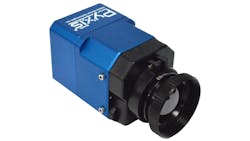New imaging polarimeter deployed by U.S. Army improves target detection through camouflage
Polaris Sensor Technologies (Huntsville, AL, USA; www.polarissensor.com), funded by the Army Research Laboratory (Research Triangle Park, NC, USA; www.arl.army.mil) and Picatinny Arsenal (Morris Country, NJ, USA; bit.ly/VSD-PCT), has developed the Pyxis sensor, an imaging polarimeter that combines infrared (IR) and polarization technology to create a new thermal imaging system.
While the new sensor is being deployed by the U.S. military to enhance its ability to detect camouflaged targets, early development of the Pyxis focused on the detection of oil spills.
The sensor is a division of focal plane polarimeter that uses a microbolometer as the underlying detector. According to a white paper titled, Pyxis: Enhanced Thermal Imaging with a Division of Focal Plane Polarimeter (bit.ly/VSD-PYX), the Pyxis utilizes a pixelated polarizing filter that changes polarization orientations from one pixel to the next, similarly to how Bayer filters change color filters.
Featuring GigE interface, the Pyxis is less than 2 cubic inches in size and weighs 83 g before a lens is attached. The microbolometer has a 17 μm pixel pitch in 640 x 512 format.
Pyxis has been field tested as a handheld unit, mounted on vehicles, and equipped onto unmanned aerial systems (UAS). According to Dr. David Chenault, president of Polaris Sensor Technologies, Pyxis can be mounted on Class 1 UAS and a drone kit for integration into off-the-shelf drones has been developed.
Polaris Sensor Technologies, in conjunction with ExxonMobil (Irving, TX, USA; www.exxonmobil.com) Upstream Research Company, published an article in SPIE in 2017 (Bellingham, WA, USA; www.spie.org) titled, New IR polarimeter for improved detection of oil on water (bit.ly/VSD-IRP), detailing the development of the Pyxis 640 LWIR sensor. The sensor was developed in response to the difficulty of detecting oil spills with IR imaging, as the thermal contrast between oil and water is small, and waves can make IR detection difficult.
In 2015, the Pyxis 640 LWIR sensor was tested on an oil spill in the Santa Barbara channel in Santa Barbara, CA, USA, and according to the SPIE paper, provided significant improvement in oil detection compared with conventional thermal cameras. According to the U.S. Army CCDC Army Research Laboratory, Pyxis can detect oil as thin as 50 μm, even in the presence of waves and spill clean-up emulsifiers.
About the Author

Dennis Scimeca
Dennis Scimeca is a veteran technology journalist with expertise in interactive entertainment and virtual reality. At Vision Systems Design, Dennis covered machine vision and image processing with an eye toward leading-edge technologies and practical applications for making a better world. Currently, he is the senior editor for technology at IndustryWeek, a partner publication to Vision Systems Design.
